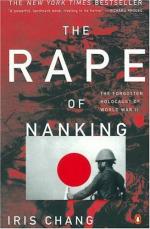|
This section contains 461 words (approx. 2 pages at 400 words per page) |

|
Epilogue Summary and Analysis
Chang notes that the Rape was not the only crime committed by the Japanese. She points to the mass extermination in Northern China, where one million individuals were slaughtered. The use of biological weapons was vital to the Japanese plan, and included the spraying of fleas infected with plague over metropolitan areas, the dumping of flasks containing cholera, dysentery, typhoid, plague, anthrax, and paratyphoid into rivers and streams, and the mixing of food with typhoid. The final death count in China over the course of the war at the hands of the Japanese is more than nineteen million people.
Chang offers several reasons for the actions of the Japanese during the war. First, she explains, the theory of "the transfer of oppression" can be applied. This theory relies on the idea that in a civilization such as Japan, where brutality is...
(read more from the Epilogue Summary)
|
This section contains 461 words (approx. 2 pages at 400 words per page) |

|




